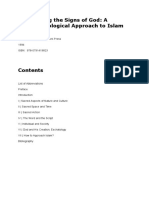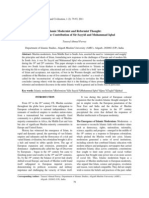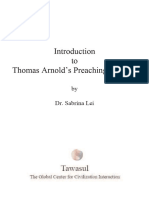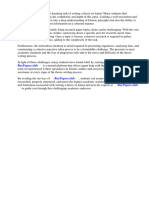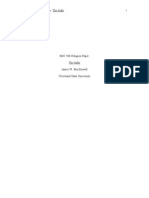The Cultural Atlas of Islam
The Cultural Atlas of Islam
Uploaded by
melikeCopyright:
Available Formats
The Cultural Atlas of Islam
The Cultural Atlas of Islam
Uploaded by
melikeCopyright
Available Formats
Share this document
Did you find this document useful?
Is this content inappropriate?
Copyright:
Available Formats
The Cultural Atlas of Islam
The Cultural Atlas of Islam
Uploaded by
melikeCopyright:
Available Formats
American J o d of Islamic Social Sciences Vol. 3, No.
1, 1986 169
Book Notice
The Cultural Atlas of Islam
Ismail and Lamya’ a1 Faruqi
This magnifrcent book, published by Macmillan a month after the Famqis’
deaths, presents the entire world view of Islam-its beliefs, traditions, institu-
tions, and its place in the cultures in which it has taken mot. THE CULTURAL
ATLAS OF ISLAM is not only a comprehensive introduction to the Islamic
experience in history and the modern world. It is an authoritative and deeply
felt statement of the faith of Islam, written for those of all faiths. Isma‘il and
Lois Lamya’ al Famqi’s book is, in fact, Islam explaining itself.
Rich with more than 300 photographs, drawings, and other illustrations,
and with some 75 original maps, this is a unique guide to the meaning of
Islam and its shaping force on cultures from the Mediterranean to the Pacific.
This is, however, much more than a history of events; it is a clear presenta-
tion of the essence of Islamic civilization in all its spheres, from everyday
practices of Muslims around the world to the Islamic legacy in art, science,
law, politics, and philosophy.
The authors begin with the ancient setting of Islam, examining the different
strands of influence-Arab, Mesopotamian, Canaanite, and Hebrew-that were
its frontrunners. Islam, the authors demonstrate, brought together diverse tradi-
tions and from them forged the unique body of belief, thought, and practice
that continues to animate Muslim life today throughout the world.
Part N o explains the concept of Tawhid-the essence of Islam that binds
together the lives of its believers. Tawhid is the affirmation of God as One,
Absolute, and Ultimate; it deeply affects all aspects of Islamic thought, ex-
pression, and behavior.
Part Three shows how this core of belief takes shape in scripture, social
institutions, and the arts-the forms which God’s revelations to Muhammad
assumed in the historical fabric of Islam. There is a concise introduction to
the fundamental nature of the Qurhn, and to the collection of Muhammad’s
sayings and deeds that clarify its statements-the Sunnah. The ways in which
Islam affects social life and its institutions-from education and family life
to the making of the Hajj, or pilgrimage, to Mecca-is also examined. So,
too, is the central role of the Qurhn in defining artistic expression.
part Four is a remarkable exploriltion of the manifestations of Islam in all
170 American Journal of Islamic Social Sciences Vol. 3, No. 1, 1986
areas of intellectual, social, artistic, political, and scientific life. Here, the
authors trace the flowering of Islam, its enormous impact on other traditions,
and its distinctive legacy in language, law, theology, philosophy, the social
sciences, history, literature, art, architecture, music, and crafts. From the ef-
fect of the Q u r h on the development of literary Arabic to the function of
ornamentation in Islamic art, from the meaning of Shritzh, or Islamic law,
to the achievements of such influential scholars as the historian Ibn Khaldun,
these chapters form a superb introduction to the entire range of Islamic
civilization.
Throughout the book, the authors pay special attention to the influence of
other traditions-Judaism, Christianity, and classical Greek philosophy, for
example-on Islam. Yet they return time and again to that which is unique
to Islam: the distinctive set of assumptions and questions Muslims use to define
the path to a just and holy life.
Rich in detail, clearly written, and integrating the best of classic and con-
tempomy scholarship, this is an exceptionally valuable book. It presents Islam
from the inside out, makes much that has been overlooked or distorted by
Western scholars clear, vital, and comprehensible, and documents for all the
reality of a religion that counts nearly a quarter of humanity as its follwoers.
This is indeed an essential addition to all libmries, and a valuable new resource
for all interested both in Islam and in the religious experience writ large.
Available from the Islamic Book Service, 109oO West Washington St..
Indianapolis, IN 46231
You might also like
- Charles Le Gai Eaton - Islam and The Destiny of ManDocument250 pagesCharles Le Gai Eaton - Islam and The Destiny of ManAdnan SaghirNo ratings yet
- the New Encyclopedia of Islam طبعة منقحة من Concise Encyclopedia of Islam بواسطة Cyril GlasseDocument334 pagesthe New Encyclopedia of Islam طبعة منقحة من Concise Encyclopedia of Islam بواسطة Cyril Glassenoman100% (1)
- (Makdisi) Religion and Culture in Medieval IslamDocument25 pages(Makdisi) Religion and Culture in Medieval IslamHajar AlmahdalyNo ratings yet
- Halabi Papers 1Document17 pagesHalabi Papers 1Aboo HafsaNo ratings yet
- Seeking Judgment From TaghoutDocument161 pagesSeeking Judgment From TaghoutTheEmigrantNo ratings yet
- Root Islamic EducationDocument96 pagesRoot Islamic EducationismailbejNo ratings yet
- The Sunna and Its Status in Islamic LawDocument18 pagesThe Sunna and Its Status in Islamic LawPriscillia DanielNo ratings yet
- Muhammad Sallallāhu Alayhi Wasallam - A Great Blessing by Maulana Muhammad Saleem DhoratDocument32 pagesMuhammad Sallallāhu Alayhi Wasallam - A Great Blessing by Maulana Muhammad Saleem DhorattakwaniaNo ratings yet
- Education From Islamic PerspectivesDocument5 pagesEducation From Islamic PerspectivesAbdulkadir Osman AbdullahiNo ratings yet
- Book Reviews: The History of Islamic Societies Is A Remarkably Ambitious and Successful One-Volume SynDocument4 pagesBook Reviews: The History of Islamic Societies Is A Remarkably Ambitious and Successful One-Volume SynUoxNo ratings yet
- Islamiat PDFDocument29 pagesIslamiat PDFHuzaifa AnwarNo ratings yet
- OP24 The Arts of Islamic Civilization - Ismail Al-Faruqi PDFDocument34 pagesOP24 The Arts of Islamic Civilization - Ismail Al-Faruqi PDFShahran KasimNo ratings yet
- Syllabus Islamic Civilization 600-1300Document2 pagesSyllabus Islamic Civilization 600-1300api-360321126100% (1)
- Islamic Civilization: Global ReligionDocument11 pagesIslamic Civilization: Global Religionanon-868593100% (3)
- Ira M. Lapidus BookDocument30 pagesIra M. Lapidus BookUoxNo ratings yet
- Ottoman Ulema, Turkish Republic: Agents of Change and Guardians of TraditionFrom EverandOttoman Ulema, Turkish Republic: Agents of Change and Guardians of TraditionNo ratings yet
- Islamic CivilizationDocument5 pagesIslamic CivilizationDAHIRUNo ratings yet
- Islamic Culture & CivilizationDocument7 pagesIslamic Culture & CivilizationMohammad TalhaNo ratings yet
- ISLAM, GLOBALIZATION AND COUNTER TERRORISM Juhaya S. PrajaDocument8 pagesISLAM, GLOBALIZATION AND COUNTER TERRORISM Juhaya S. PrajaMatejic MilanNo ratings yet
- Schimmel Deciphering SignsDocument287 pagesSchimmel Deciphering SignsHusni ZulkarnainNo ratings yet
- Islam and Civilization (Analysis Study On The History of Civilization in Islam) Muhammad Hifdil IslamDocument18 pagesIslam and Civilization (Analysis Study On The History of Civilization in Islam) Muhammad Hifdil IslamLoveth KonniaNo ratings yet
- Sabaht&Rozina, Presentation, History of Islamic CivilizationDocument26 pagesSabaht&Rozina, Presentation, History of Islamic CivilizationSabaht KhurshidNo ratings yet
- Islam Historical, SocialDocument453 pagesIslam Historical, SocialAmir Iqbal100% (4)
- Islamic Modernist and Reformist ThoughtDocument15 pagesIslamic Modernist and Reformist ThoughtShawn SyazwanNo ratings yet
- Introduction To Thomas Arnolds PreachingDocument85 pagesIntroduction To Thomas Arnolds PreachingSehar AslamNo ratings yet
- Deciphering The Signs of GodDocument321 pagesDeciphering The Signs of GodPddfNo ratings yet
- Ramadan, Tariq - Islam and The Arab Awakening (2011, Oxford University Press, USA) - 78-106Document29 pagesRamadan, Tariq - Islam and The Arab Awakening (2011, Oxford University Press, USA) - 78-106Ahmed Ben hamouNo ratings yet
- Mohammad Ibn Ahmad Abu Rayhan Biruni: Muslim Pioneers in Science, Medicine and LiteratureFrom EverandMohammad Ibn Ahmad Abu Rayhan Biruni: Muslim Pioneers in Science, Medicine and LiteratureNo ratings yet
- Islam Research Paper TopicsDocument4 pagesIslam Research Paper Topicsafmchbghz100% (1)
- Arab History EssayDocument7 pagesArab History EssayNL HardyNo ratings yet
- Vernon O. Egger - A History of The Muslim World To 1405 - The Making of A CivilizationDocument484 pagesVernon O. Egger - A History of The Muslim World To 1405 - The Making of A CivilizationGiulli HelenNo ratings yet
- Islamic Culture FinalDocument49 pagesIslamic Culture Finalshadabkhan1603No ratings yet
- Maisonneuve & LaroseDocument34 pagesMaisonneuve & Larosehalil başkanNo ratings yet
- Diversity and Unity in Islamic Civilization: A Religious, Political, Cultural, and Historical AnalysisFrom EverandDiversity and Unity in Islamic Civilization: A Religious, Political, Cultural, and Historical AnalysisNo ratings yet
- Combine ThesisDocument80 pagesCombine ThesisAdan ChNo ratings yet
- The Impact of Islam On Eurpean CivilizationDocument22 pagesThe Impact of Islam On Eurpean Civilizationwww.alhassanain.org.english100% (10)
- Spiritual Descendants of The Prophet AlDocument39 pagesSpiritual Descendants of The Prophet AlAbdul MoaizNo ratings yet
- Research Paper IslamDocument9 pagesResearch Paper Islamfzfgkws3100% (1)
- Islam: Global Christian Perspectives: Voices of Majority World Christian Scholars of IslamFrom EverandIslam: Global Christian Perspectives: Voices of Majority World Christian Scholars of IslamWageeh MikhailNo ratings yet
- Tarek Osman - Islamism - A History of Political Islam From Fall of The Ottoman Empire To The Rise of ISIS (2017, Yale University Press) - Libgen - LiDocument340 pagesTarek Osman - Islamism - A History of Political Islam From Fall of The Ottoman Empire To The Rise of ISIS (2017, Yale University Press) - Libgen - Lijawadbazai69No ratings yet
- Histm13 1Document8 pagesHistm13 1api-666387735No ratings yet
- 129-143, Farman Ali AND Humaira Ahmad, Early Christian Sīrah Writings of Subcontinent PDFDocument15 pages129-143, Farman Ali AND Humaira Ahmad, Early Christian Sīrah Writings of Subcontinent PDFFarman AliNo ratings yet
- Ismaili Myth Shared With KaballaDocument24 pagesIsmaili Myth Shared With KaballaDr.Ahmed GhareebNo ratings yet
- 132-Article Text-254-1-10-20150613 PDFDocument22 pages132-Article Text-254-1-10-20150613 PDFdevy febriastiNo ratings yet
- Islam Phobia John EspostisoDocument99 pagesIslam Phobia John EspostisoAinaa NadiaNo ratings yet
- THE HOLy QUPAN AND THE ORIENTALISTSDocument390 pagesTHE HOLy QUPAN AND THE ORIENTALISTSMehmood ChawlaNo ratings yet
- 914 - Ajiss23-4-Stripped - AbuMunshar - Islamicjerusalem - A Model For MulticulturalismDocument25 pages914 - Ajiss23-4-Stripped - AbuMunshar - Islamicjerusalem - A Model For MulticulturalismAbah JufriNo ratings yet
- The Politics of Knowledge in Premodern Islam: Negotiating Ideology and Religious InquiryFrom EverandThe Politics of Knowledge in Premodern Islam: Negotiating Ideology and Religious InquiryNo ratings yet
- Hoexter Et Al Eds - The Public Sphere in The Muslim WorldDocument202 pagesHoexter Et Al Eds - The Public Sphere in The Muslim WorldChristopher TaylorNo ratings yet
- Sufi Shaykhs and Society in Thirteenth and Fifteenth Century Anatolia Spiritual Influence and Rivalry PDFDocument24 pagesSufi Shaykhs and Society in Thirteenth and Fifteenth Century Anatolia Spiritual Influence and Rivalry PDFmoonwalker18100% (1)
- Muhammad The Prophet of IslamDocument72 pagesMuhammad The Prophet of IslamChristine CareyNo ratings yet
- Islam without Europe: Traditions of Reform in Eighteenth-Century Islamic ThoughtFrom EverandIslam without Europe: Traditions of Reform in Eighteenth-Century Islamic ThoughtNo ratings yet
- 1966 Nasr IdealsandRealitiesofIslam 1994+2000 BiblioDocument27 pages1966 Nasr IdealsandRealitiesofIslam 1994+2000 BibliobrizendineNo ratings yet
- EDC 500 Religion PaperDocument8 pagesEDC 500 Religion Paperwellmac1No ratings yet
- Cambridge University Press Comparative Studies in Society and HistoryDocument30 pagesCambridge University Press Comparative Studies in Society and HistorySpiritNo ratings yet
- Contricution of Islamic Civilization To World AdvancementDocument21 pagesContricution of Islamic Civilization To World AdvancementMohammad Ameen BhattiNo ratings yet
- Contribution of Muslim Scholars To The WorldDocument20 pagesContribution of Muslim Scholars To The WorldGhulam FaridNo ratings yet
- Islamic Fundamentalism: 2. Intellectual OriginsDocument4 pagesIslamic Fundamentalism: 2. Intellectual Originsİbrahim ÇataldaşNo ratings yet
- The Princeton Encyclopedia of Islamic Political ThoughtFrom EverandThe Princeton Encyclopedia of Islamic Political ThoughtRating: 3.5 out of 5 stars3.5/5 (4)
- Annisa Kartika Ocktavia - ANALYSIS STUDY ON THE HISTORY OF CIVILIZATION IN ISLAMDocument5 pagesAnnisa Kartika Ocktavia - ANALYSIS STUDY ON THE HISTORY OF CIVILIZATION IN ISLAMAnnisaKartika OcktaviaNo ratings yet
- Islam Essay ThesisDocument4 pagesIslam Essay ThesisWriteMyEnglishPaperForMeUK100% (2)
- Islamic Culture AssignmentDocument6 pagesIslamic Culture AssignmentMuhammad IbrahimNo ratings yet
- Islam Dan Peradaban MelayuDocument22 pagesIslam Dan Peradaban MelayuJihanNo ratings yet
- The Nature of TerrorismDocument32 pagesThe Nature of TerrorismSheni Ogunmola0% (1)
- Al HijrahDocument30 pagesAl HijrahIrishMujNo ratings yet
- Omaira T. Alam-A Dignified Way of Raising The Standards of CDocument14 pagesOmaira T. Alam-A Dignified Way of Raising The Standards of CAien HarukoNo ratings yet
- Islam Paperback EvilDocument468 pagesIslam Paperback Evilविशाल रंजनNo ratings yet
- Ghulam Pervaiz Deceivers 2Document5 pagesGhulam Pervaiz Deceivers 2Fitna__Inkaar__Hadees__The__deception__of__Hadith__RejectorsNo ratings yet
- Kulliyah of Education International Islamic University Malaysia Master of Education Final Examination SEMESTER 1 - 2019/2020 (Take Home Examination)Document2 pagesKulliyah of Education International Islamic University Malaysia Master of Education Final Examination SEMESTER 1 - 2019/2020 (Take Home Examination)Syamim KhaidiNo ratings yet
- Shaykh Al-Hadith Fazlur Rahman Azmi by Mufti Atiqur Rahman AzmiDocument71 pagesShaykh Al-Hadith Fazlur Rahman Azmi by Mufti Atiqur Rahman AzmiMuhammad Suffyan Eddie100% (1)
- How To Study The QuranDocument51 pagesHow To Study The QuranFazlurrehmanmemon100% (1)
- Organ Transplant in Islam, Two Roads of The Same PathDocument17 pagesOrgan Transplant in Islam, Two Roads of The Same Pathabduh_hafidzNo ratings yet
- Khutba On WaqfDocument4 pagesKhutba On WaqfUmar WillsNo ratings yet
- Fiqh of MarriageDocument30 pagesFiqh of MarriageNawaid ZamanNo ratings yet
- Introduction To Islamic Law: Lily Zakiyah MunirDocument17 pagesIntroduction To Islamic Law: Lily Zakiyah MunirAmanda Lucky BerlianNo ratings yet
- التخريجDocument122 pagesالتخريجputriNo ratings yet
- Islamic Concept of Human RightsDocument18 pagesIslamic Concept of Human RightsJunaid Lucas0% (1)
- The Fundamental Principles of Imam Malik's Fiqh: (Muhammad Abu Zahrah)Document44 pagesThe Fundamental Principles of Imam Malik's Fiqh: (Muhammad Abu Zahrah)Aubrey AquinoNo ratings yet
- Q. What Are The Main Themes Discussed in Surah-Al Hujurat? Discuss Any Two Incidents/traditions With Reference To ThoseDocument3 pagesQ. What Are The Main Themes Discussed in Surah-Al Hujurat? Discuss Any Two Incidents/traditions With Reference To ThoseTahir KhanNo ratings yet
- Unmasking Ahle'QuranDocument16 pagesUnmasking Ahle'QuranYusuf241953No ratings yet
- Islamicpersonallaw-160507144700 2Document85 pagesIslamicpersonallaw-160507144700 2Goharz2No ratings yet
- HADITH A Re-Evauation by Kassim Ahmad PDFDocument156 pagesHADITH A Re-Evauation by Kassim Ahmad PDFGozain MudzakirNo ratings yet
- Albani and His FriendsDocument47 pagesAlbani and His Friendsmohsin100% (3)
- Learning About The Angels: Jibreel Meekaa'eel Israafeel Munkar NakeerDocument4 pagesLearning About The Angels: Jibreel Meekaa'eel Israafeel Munkar NakeerErna Karlinna D. YanthyNo ratings yet
- Status of Sunnah in IslamDocument6 pagesStatus of Sunnah in IslamThe Holy Islam100% (1)
- Democratic Elections and Those Who Permitted ThemDocument16 pagesDemocratic Elections and Those Who Permitted ThemLonemanNo ratings yet
- Muhammadan LawsDocument130 pagesMuhammadan LawsRajaNo ratings yet
- Robson - Tradition 1 MW 1951Document12 pagesRobson - Tradition 1 MW 1951Arputharaj SamuelNo ratings yet




















